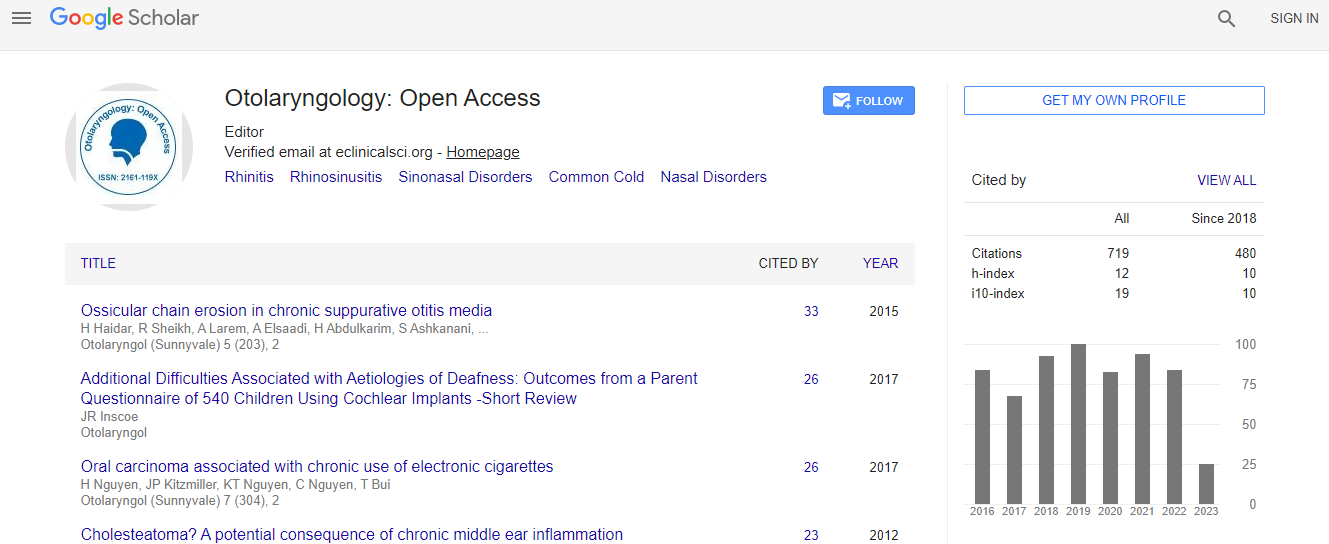Our Group organises 3000+ Global Conferenceseries Events every year across USA, Europe & Asia with support from 1000 more scientific Societies and Publishes 700+ Open Access Journals which contains over 50000 eminent personalities, reputed scientists as editorial board members.
Open Access Journals gaining more Readers and Citations
700 Journals and 15,000,000 Readers Each Journal is getting 25,000+ Readers
Google Scholar citation report
Citations : 925
Otolaryngology: Open Access received 925 citations as per Google Scholar report
Otolaryngology: Open Access peer review process verified at publons
Indexed In
- Index Copernicus
- Google Scholar
- Sherpa Romeo
- Open J Gate
- Genamics JournalSeek
- RefSeek
- Hamdard University
- EBSCO A-Z
- OCLC- WorldCat
- Publons
- Geneva Foundation for Medical Education and Research
- ICMJE
Useful Links
Recommended Journals
Related Subjects
Share This Page
Application of Chemical peels
International Conference on Aesthetic Medicine and ENT
Masroor Ahmad Wani
Health Zone (Aesthetic & Skin Chamber), India
ScientificTracks Abstracts: Otolaryngology
Abstract
A chemical peel is used to improve the appearance of the affected skin. A chemical peel solution is applied to the skin that eventually peels off the affected area. The new, regenerated skin is usually smoother and less wrinkled than the old skin. The new skin is temporarily more sensitive to the sun. Three basic kinds of chemical peels are: Superficial peel: Alpha-hydroxy acid or any another mild acid is used to penetrate only the outer layer of skin to gently exfoliate it. The treatment is used to improve the appearance of mild skin discoloration and rough skin as well as to refresh the affected area. Medium peel: Glycolic acid is used to penetrate the out and middle layers of skin to remove damaged skin cells. The treatment is used to improve age spots, fine lines and wrinkles, acne spots, freckles. Deep peel: Phenol or trichloroacetic acid is applied to deeply penetrate the middle layer of skin to remove damaged skin cells. The treatment removes moderate lines, age spots, freckles and shallow scars. Patients feel good improvement in skin appearance. Who is a good candidate for a chemical peel? Generally, fair-skinned and light-haired patients are better candidates for chemical peels. If you have darker skin, you may also have good results, depending upon the type of problem being treated. But you also may be more likely to have an uneven skin tone after the procedure.Biography
Masroor Ahmad Wani is Gold Medalist, has done MD from Medical College, Kolkata. He is practicing Aesthetic and Skin Medicine at Health Zone Medicate, Srinagar, India. He has published many articles in newspapers and magazines, has attended more than 22 national and international dermatological conferences.
Email: healthzone@live.com

 Spanish
Spanish  Chinese
Chinese  Russian
Russian  German
German  French
French  Japanese
Japanese  Portuguese
Portuguese  Hindi
Hindi 
